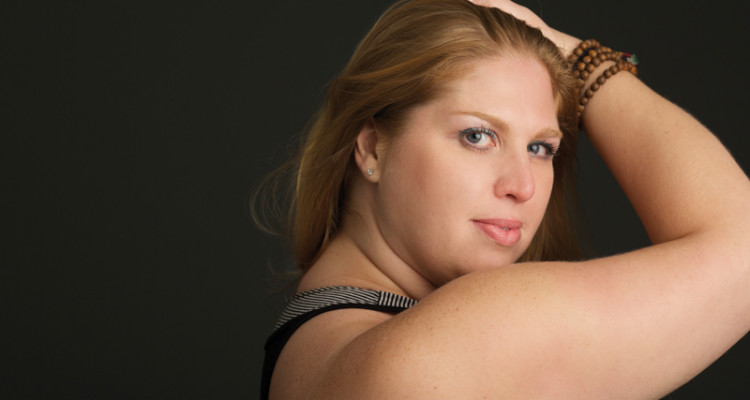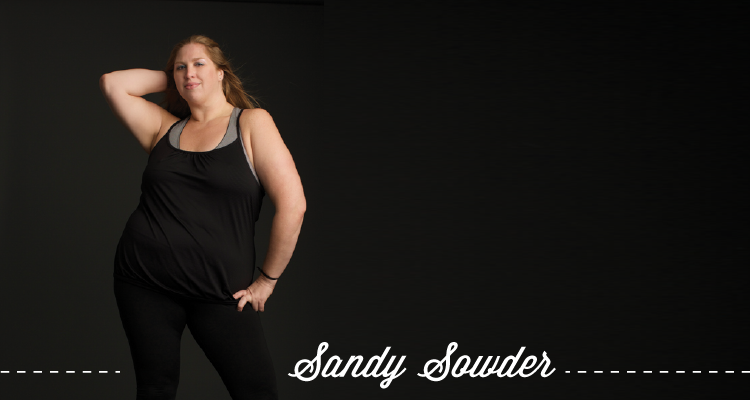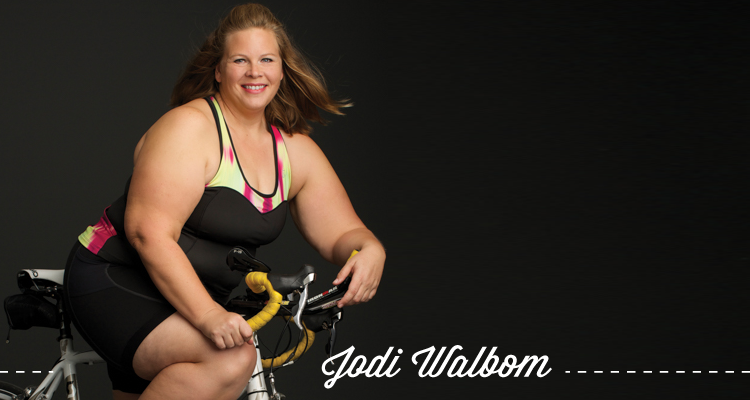Why plus-sized athletes have it better than you.
Sumo wrestlers. Linebackers. Olympic power lifters. Men can be large in stature but still considered athletes. But can you think of a sport where a woman is large and legitimized as an athlete?
An athlete, says society, should look a certain way. And if you look (heaven forbid) different than that, you are up for some serious scrutiny.
What should matter is that as an athlete you behave a certain way. You set goals. You work on your skills. You constantly seek to better yourself. You go back day after day and never quit (at least not for very long). In your heart, the word athlete should speak to who you are at your core.
Nowhere in there is the caveat: And your muscles must ripple from beneath your spandex. Sure, that can be a side effect of participating in sports—but then so are sprained ankles and obsessively worrying about port-a-johns. Those shouldn’t define us as athletes so why should our body size?
Plus-sized women (and men) do not have to be less successful than their skinny counterparts in sport. And, more than ever before, athletes of all sizes, ages and persuasions are signing up for races and joining teams and hitting the streets. They’re not only changing the way we define an athlete, we believe they are some of the best athletes out there, authentically experiencing the joy of competition, more than even the most sinewy runner, cyclist or CrossFitter. Here’s why, as told by three local multisport competitors—who also happen to be plus-sized.
She does it for the right reasons (and it’s not to lose weight).
It’s not a secret that fitness and athletics can be superficial. Maybe we don’t talk about it, but part of fitting in as an athlete involves a complicated and sometimes unsaid awareness of whether or not you “look the part.”
“It can be really intimidating to walk into a gym or sign up for a triathlon when you have, like, 100 pounds on everybody. You kind of second guess yourself and then you say—no, I can do this,” says Sandy Sowder, a 36-year-old who’s a paralegal by day, a yoga instructor by night, and has competed in triathlons.
When your body size isn’t the status quo, you have to actively counter the feeling that you don’t belong because, well, you don’t look the same. That casual perfection bias is stripped away when you’re big and all that is left is—by necessity—other, better motivations. And despite all the marketing we see about all exercise magically leading to weight loss, you can run a triathlon, clean and jerk an incredible amount of weight or destroy your swim competition while not losing a single pound.
“I’ve accepted the fact that I’m not going to be skinny, I don’t have the ability to be a size 4, it’s not in my cards. It’s important to be healthy and you can still be overweight and healthy,” says Sowder.
Successful plus-sized athletes, rather than relying on looking like they belong, instead focus on doing the actual sport—and loving it. “You have to really like what you’re doing and that’s what makes you want to do it,” Sowder says. So while average size girls are suffering boring exercises over and over, hoping those abs will soon appear, the thick girls are discovering their passions and really paying attention to their bodies.
“I love that powerful feeling—that I’m strong. I know how miserable it feels when I’m not exercising and I’m not trying, I feel lousy, I feel unhealthy. For me, it’s about honoring what you want—listening to your body, and shutting out the external chatter and listening to yourself,” says Sowder.
So the wonderful advantage plus-sized athletes have is help in the realization that the journey of an athlete is internal and measured by those things, versus an external journey where success is marked by a number or a size.
Take for example, Jodi Walborn a married mother of five who describes herself as “non-athletic. My least favorite class in high school was PE.” Although she’d never been an athlete before, after her car was totaled in 2010, she decided to buy a bike instead of replacing it. “I needed to lose weight and I no longer had a mode of transportation—so I thought I’d kill two birds with one stone.” A funny thing happened, though—what started off as a way to shed pounds turned into something else.
“The more I rode the more I fell in love with it. When I’m on my bike, there’s that freedom of being a kid. I feel 12 again. I am not a married mother of five; I don’t have to worry about what I’m cooking for dinner. When I’m on my bike, I’m free just for a little while.” Notice that there’s nothing in there about how much weight she lost, how her pant size went down (which it did). What is in there is fun, and love and a newfound appreciation for what her body can do.
“For me, being an athlete is pushing my perception of my own boundaries,” says Katy Esquivel, a corporate attorney, new mom, and plus-sized runner and triathlete. “Every time I push past one of them or have a faster time than I did at a race the year before, I feel good about myself. We’re all out there for different reasons. One guy might be out there to set records. Or you see somebody in military gear with a backpack on and they’re doing [it] for another reason. And they’re all personal and important.”
Esquivel did her first triathlon in 2010 after her husband was diagnosed with cancer. “It was extraordinarily stressful; he’d been misdiagnosed for two years, he’d been on all sorts of drugs, we finally got an answer and it was a scary one.
“I didn’t have a constructive way to deal with the stress and anxiety and terror of the future. That’s when my friend said ‘let’s do the triathlon—it will be a good diversion.’ I didn’t realize it at the time, but that’s when the turn came of not [exercising] for the purpose of keeping my weight under control. That was a shift.”
She has better workout buddies.
Eqsuivel had a great friend who believed in her abilities and encouraged her to do a triathlon. That’s not uncommon experience for plus-sized athletes. Big women in athletics usually have particularly awesome friends.
Because, listen, sometimes people are jerks. And sometimes people seem nice at first, then turn out to be jerks. For fat athletes, you find out who’s awesome and who’s not—very quickly.
“When you’re a bigger athlete, people are dismissive of you,” says Esquivel. When she joined her first running group in 2011, she said he felt “like a seventh grader in PE.”
“I got lapped on the track during a warm up,” she says. “But the people I met were so supportive and kind and welcoming. The super fast skinny guys who do a six- and seven-minute mile were cheering me on.”
Esquivel saw the flip side, too, that same day. “We shared the track with another group that was elitist and not nice. Those runners, when they were done with their lap, would stay in my lane and they didn’t care that this big girl was trying to finish her workout.”
Yoga teacher Sowder says being in the yoga community can be particularly uncomfortable, as it is a sport evocative of the lean, long archetype. “I’m lucky, the studio I practice at is very warm, friendly. It’s like a family. From the minute I walked in that studio I felt welcomed. Even though everyone else in the room is significantly skinnier than me, I never felt too uncomfortable there.” But that warmth isn’t the only yoga experience she’s had.
“I’ve gone to other studios where I’ve … paid for a month and then never ever showed my face again.”
Too often we think our athletic lives exist in a vacuum, but we all need community to meet personal goals—we want to feel encouraged, helped, supported or just simply comfortable. Though it doesn’t happen on day one, plus-sized athletes—almost without an exception—find great people to experience their sport with.
She’s tough as nails, inside and out.
That plus sized girl at the gym? The workout she’s doing is harder for her than for you. And she doesn’t complain. There is a whole host of ways that working out is difficult when you’re bigger, some of those are physical, and some are mental.
“I think what people don’t realize is having been over 300 pounds for so many years, I have to contend with extra weight and arthritis—and I’m still going to beat you on the bike!” says Walborn, laughing. “I’m fast and I’m strong on the bike.”
Besides it being physically harder for her, there are other obstacles average-sized racers never encounter—a not-so-subtle size bias. “One time, I went into the bike store for a very specific seat and the gentleman looked me up and down and said: “But that’s for triathlons.” So I said: “Yes, it’s for my Scott S20 and for my race next month.”
Humbled, the man apologized. “It was okay once I demonstrated what I knew—but his first impression of me was “why is this fat chick asking for a race saddle?”
And on the topic of gear—that is a word that strikes fear into the hearts of plus-sized athletes everywhere. Things just aren’t made for big bodies racing, running and asana-ing. “Try finding a pair of tri shorts in a 2X!” Walborn says.
“I don’t understand why they can’t make work out clothes [for] bigger people—they’re starting to, but you have to look really hard for it,” says yoga teacher Sowder. “You can’t just walk in to Lululemon and buy something. I’m a good looking person, there’s no reason why I should feel like I have to hide behind big t-shirts and baggy sweatshirts!”
She’s changing the world of sport.
“When I’m on my bike, I pass a lot of people,” says Walborn. “I’ve heard some people say derogatory comments, and some will say ‘Woah, she’s fast!’ It’s the shock behind their voices—like ‘she’s really big and she’s really fast.’”
These women, all plus-sized, by simply being out there and doing it are becoming role models and boundary breakers, challenging the notion that in some way fat equals weak.
“I did a triathlon in Orlando—I used to be a competitive swimmer—so I’m a really good swimmer,” says Sowder. “I was the first one out of the water by a minute. As I’m running past, I heard someone say: ‘Wow, that big girl can swim!’ I thought that was so funny. I was thinking: ‘Yeah, of course I can swim. Just because I’m a big girl doesn’t mean I can’t swim! It doesn’t make me any less of an athlete because I have different genes than other people.”
But change is hard. Big athletes participating in races can bring out both the best and worst in humanity. “Either you love seeing a fat girl racing or you hate it. There’s not a lot of in-between,” says Esquivel.
But the times are changing for plus-sized athletes as more and more abandon the confines of weight-loss workouts for the fun and challenge of sports. “[At] a lot of the races in Fort Myers or Naples, I don’t see a lot of women my size. I see a lot of men in Clydesdale division,” says Esquivel. “When I went to Tri-Rock in Clearwater, I saw women my size. It was shocking and reinforcing.”
The starting line is the domain of anyone who pins a number to their shirt and dares to line up. The size of that shirt doesn’t make one person more or less worthy of being there. So the next time you get passed by a larger-than-average athlete, don’t be surprised, As she passes you, you can be sure she’s not going anywhere but forward. And fast.
Want more inspiration? Read on:
The Athlete’s Heart – A Conversation With Mary Carillo
Good Habits Die Hard: Triathlete Sarah Piampiano Discusses Motivation, Perseverance, and Balance
I Came to be Awesome at Crossfit, Not Skinny



